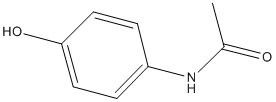All AbMole products are for research use only, cannot be used for human consumption.

Acetaminophen (Paracetamol) is a selective cyclooxygenase-2 (COX-2) inhibitor with an IC50 of 25.8 μM. Acetaminophen is a widely used antipyretic and analgesic agent. Acetaminophen is a potent hepatic N-acetyltransferase 2 (NAT2) inhibitor. Acetaminophen induces ferroptosis and leads to acute liver injury in mice model.
Acetaminophen plasma concentrations remaine above the in vitro IC50 for COX-2 for at least 5 h postadministration. Ex vivo IC50 values (COX-1: 105.2 μM; COX-2: 26.3 μM) of acetaminophen compared favorably with its in vitro IC50 values. In contrast to previous concepts, acetaminophen inhibited COX-2 by more than 80%, i.e., to a degree comparable to nonsteroidal antiinflammatory drugs (NSAIDs) and selective COX-2 inhibitors.
Administering Acetaminophen (250 mg/kg, orally) to the mice causes significant (p<0.001) liver damage and necrosis of cells as evidenced by the elevated serum hepatic enzymes alanine aminotransferase (ALT), aminotransferase (AST), alkaline phosphatase (ALP), and gamma-glutamyl transferase (γGT) compared with normal group. Acetaminophen (300 mg/kg, i.p., single dose) induces ferroptosis, by enhancing levels of Fe2+ and malondialdehyde (MDA), and decreasing levels of glutathione (GSH) and glutathione peroxidase 4 (GPX4), and induces acut eliver injury in C57BL/6J mice model.
*The compound is unstable in solutions, freshly prepared is recommended

FASEB J. 2025 Jan 07;39(1):e70272.
The C3/C3aR pathway exacerbates acetaminophen‐induced mouse liver injury via upregulating podoplanin on the macrophage
Acetaminophen purchased from AbMole

Patent. CN116554248A 2023 Aug 08.
Patent. CN116554248A
Acetaminophen purchased from AbMole
| Molecular Weight | 151.16 |
| Formula | C8H9NO2 |
| CAS Number | 103-90-2 |
| Solubility (25°C) | DMSO 60 mg/mL Water 10 mg/mL |
| Storage |
Powder -20°C 3 years ; 4°C 2 years In solvent -80°C 6 months ; -20°C 1 month |
[1] Clyde J Wright. Acetaminophen and the Developing Lung: Could There Be Lifelong Consequences?
[2] Anita Aminoshariae, et al. Acetaminophen: old drug, new issues
[3] K Brune, et al. Acetaminophen/paracetamol: A history of errors, failures and false decisions
[4] Marta Jźwiak-Bebenista, et al. Paracetamol: mechanism of action, applications and safety concern
| Related Animal Modeling Products |
|---|
| 3,4-Benzopyrene
3,4-Benzopyrene shows lung carcinogenicity in animal models. |
| Sodium Thioglycolate
Sodium thioglycolate acts as reducing agent and is suitable for anaerobic and microaerophilic bacterial growth. Sodium thioglycolate is a commonly used reagent for bacteriological research to maintain reducing conditions in media. Thioglycolate can also protect enzymes against inactivation by maintaining protein thiol groups in the reduced state. Thioglycolate medium is frequently used in inflammation research to elicit a neutrophil and macrophage response in vivo. |
| Vancomycin-d10 2TFA salt
Vancomycin-d10 2TFA salt |
| Acetic acid-d4
Acetic acid-d4 |
| Myosin H Chain Fragment, mouse acetate
Myosin H Chain Fragment, mouse acetate salt is a fragment of the α-Myosin heavy chain peptide. Myosin H Chain Fragment can be used to induce experimental autoimmune myocarditis (EAM) mouse model. |
All AbMole products are for research use only, cannot be used for human consumption or veterinary use. We do not provide products or services to individuals. Please comply with the intended use and do not use AbMole products for any other purpose.


Products are for research use only. Not for human use. We do not sell to patients.
© Copyright 2010-2024 AbMole BioScience. All Rights Reserved.
